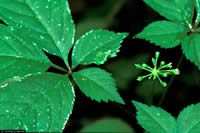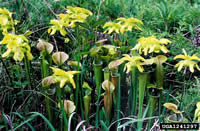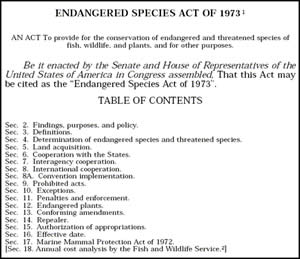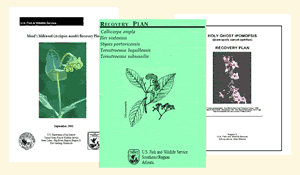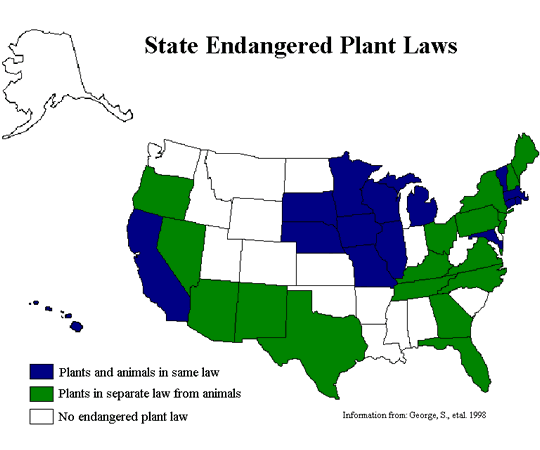USDA Forest Service Celebrating Wildflowers
|
|
|
Laws and Regulations to Protect Endangered PlantsInternationalThe Convention on International Trade in Endangered Species of Wild Fauna and FloraThis Convention (more commonly known by its acronym CITES) is an agreement between governments worldwide to ensure that international trade in wild plants and animals does not threaten their survival. CITES began in 1975 with 80 participating nations. Now, 169 nations participate and the agreement protects more than 30,000 species of plants and animals. International trade in wildlife and plants is worth billions of dollars annually and includes hundreds of millions of plant and animal specimens. The trade is diverse, ranging from live plants and animals to a vast array of products derived from them, including foods, exotic leather goods, wooden musical instruments, timber, tourist curios, and medicines. The extensive international trade of some plants and animals, together with factors like habitat loss, threatens to deplete some to the point of near extinction. Species protected under CITES are placed on one of three lists (appendices) depending on the degree that international trade threatens their existence:
The U.S. Fish and Wildlife Service is responsible for implementing CITES in the United States. Information about CITES and permits is available at the Service’s International Affairs website. Examples of plants protected from international trade under CITES include orchids, cacti, pitcher plants, some cycads and palms, ginseng, goldenseal, and some tropical timber trees. Some of these plants grow on national forests and grasslands where they are managed to ensure their perpetuation as viable populations and, where possible, for sustainable commercial use Case Studies
American ginseng (Panax quinquefolius) is on Appendix II of CITES because the large quantity of wild-collected plants sold internationally threatens to deplete the species. Ginseng has a broad range in the eastern half of the United States. It has been documented in 33 states and 2 Canadian provinces. Collecting ginseng is not permitted on most national forests at the edge of ginseng’s range where populations are few and scattered. Controlled wild harvest is allowed in seven states and on seven national forests at the heart of ginseng’s range. Here, the states and national forests have created permit systems and harvesting rules. For example, on the Wayne National Forest in Ohio, harvesters must get a permit and can harvest only in designated areas during the harvest season. They can harvest only mature plants and cannot exceed their harvest limit. Harvesters must plant the ripe fruits from plants they collect. They must return their permit with harvest information at the end of the season so the amount of harvest can be tracked. These types of management provisions make it possible to sustain wild ginseng harvests in the United States.
Green pitcher plant (Sarracenia oreophila) is on Appendix I of CITES because carnivorous plants like green pitcher plant are popular novelties in the horticultural trade and because green pitcher plant is extremely rare and endangered. Green pitcher plant is also listed as endangered under the Endangered Species Act. A coordinated effort between private, State, and Federal entities, including the U.S. Forest Service, is ongoing to recover the species. International trade in wild-collected Appendix I species is not allowed, but CITES has provisions to reduce illicit trade by encouraging trade in nursery-grown plants. Permits are granted for international trade of artificially propagated Appendix I plants so long as the permit requestor can demonstrate the plants are nursery grown from legally acquired stock. Questions about details of the CITES permit program are available from the U.S. Fish and Wildlife Service. NationalThe Endangered Species Act of 1973
In the 1960s and early 1970s, the public became increasingly concerned about the decline of various plants and animals due to human exploitation and/or habitat destruction. Prior acts of Congress had protected some wildlife, but the Endangered Species Act of 1973 was the first Federal legislation to protect endangered plants. The U.S. Fish and Wildlife Service was given the principal responsibility for carrying out the mandates of the Act. The entire Act can be found at the Fish and Wildlife Service’s website. The following paragraphs summarize some important aspects of the Act as they relate to plants. Section 3 of the Act defines various terms. Species are defined to include named subspecies and varieties of plants as well as full species. Thus, for example the subspecies Argemone pleiacantha ssp. pinnatisecta and the variety Echinocereus fendleri var. kuenzleri are on the list of endangered plant species. Endangered is defined to mean any species that is in danger of extinction throughout all or a significant part of its range. Threatened is defined to mean any species that is likely to become an endangered species within the foreseeable future throughout all or a significant part of its range. Critical habitat is defined as specific areas that are essential to the conservation of a species and that may require special management or protection. The U.S. Fish and Wildlife Service identifies these areas on maps in a formal process. Once designated, critical habitat areas receive greater protection than other areas. The U.S. Fish and Wildlife Service is responsible for designating plants as endangered or threatened (Section 4 of the Act). These decisions are based solely on the best scientific and commercial information available. Areas of critical habitat may also be designated in conjunction with listing. As of 2006, there were 747 plants listed as endangered or threatened. There are 117 endangered or threatened plants on national forests and grasslands. Brief profiles are available for each of these plants. Section 9 of the Act describes protections for endangered plants. One set of protections involves transport and trade. Import or export of endangered plants from the United States is prohibited, as is receipt, delivery, or sale in interstate or foreign commerce. Another set of protections involves collecting or damage. It is prohibited to remove and reduce to possession or maliciously damage or destroy endangered plants on Federal lands. For private lands, it is illegal to collect, damage, or destroy endangered plants in violation of a state law including state criminal trespass law. Very few states prohibit landowners from collecting or destroying endangered plants on their own private property, so endangered plants on private property have minimal protection. Protections for threatened plants are similar to those for endangered plants, but the protections were created through regulations published by the Fish and Wildlife Service rather than being stated directly in the Act. Why aren’t endangered plants protected from taking on private lands?Endangered plants on private lands can be taken without penalty (unless a State law prohibits such taking), but this is not the case for endangered animals that are protected from taking on both public and private lands. Why the difference? Federal and State wildlife laws in the United States have their origins in old English common law where the King and Parliament owned the wild animals and prescribed the ways that ordinary citizens could harvest them on all lands, public or private. Conversely, plants were considered to be a part of the land on which they grew, and thus plants on private lands were treated as the owner’s private property. This ownership difference has been carried forward in the different ways that plants and animals are protected in the Endangered Species Act. Section 10 of the Act describes conditions under which the Fish and Wildlife Service will grant permits to carry out otherwise prohibited acts. Permits can be obtained for scientific study or to enhance the propagation or survival of the species. For plants in commerce, permits are available for interstate or international sale of artificially propagated plants, thus reducing the demand for wild-collected plants. Various provisions of the Act promote the conservation and recovery of endangered plants. Section 7 of the Act directs all Federal agencies to use their authorities to carry out programs for the conservation of endangered or threatened species. This section further directs Federal agencies to ensure that no actions they authorize, fund, or carry out are likely to jeopardize the continued existence of an endangered or threatened species. This includes Federal actions on private lands, so it is one way that plants on private lands get some protection under the Act. Federal agencies must evaluate their actions and consult with the U.S. Fish and Wildlife Service on actions that may affect threatened or endangered species. If an agency determines that an action may adversely affect a threatened or endangered species, then the agency must request formal consultation with the Fish and Wildlife Service. The Service is required to write a document called a "Biological Opinion" that determines if the action will jeopardize the continued existence of the species. If the conclusion is "jeopardy," then the Service describes measures called "Reasonable and Prudent Alternatives" that the agency must take to lower the level of impact below jeopardy. If the conclusion is "non-jeopardy," the Service usually provides Conservation Recommendations that the agency may take to reduce the adverse impacts of the action.
The Fish and Wildlife Service is required to write a recovery plan for each endangered or threatened species. These plans give background information about the species, describe conservation measures, estimate costs, and give recovery goals that when met will allow the species to be removed from the endangered species list. Recovery plans completed since 1989 are available from the Fish and Wildlife Service. Section 6 of the Act encourages the establishment of cooperative agreements between the Fish and Wildlife Service and State agencies for the conservation of endangered and threatened species. These agreements are between the Service and the State agency responsible for implementing the State endangered species law, or if there is no State law, then the agreement is with the State agency that has authority to do research and conservation on rare and/or endangered plants. Under these agreements, the Service will provide up to 75 percent of the cost of conservation projects that the State and Service mutually agree to conduct. Under Section 5 of the ESA, endangered or threatened species habitat may be acquired by purchase, donation, or other mechanisms. This section also allows these Federal agencies to use funds from the Land and Water Conservation Fund Act of 1965, as amended, for habitat acquisition. StateMany states have their own endangered plant law. In 15 states, plants are part of the overall state endangered species act. In 17 other states, endangered plants have their own protective act separate from animals. Eighteen states have no state-level endangered plant law. Most state laws provide fewer and weaker protections for endangered plants than the Federal Endangered Species Act. Like the Federal act, most State laws provide no or minimal protection for endangered plants on private lands. Penalties for violation of state laws are usually minimal. Very few state laws require state agencies to consult on their projects that may damage endangered plants. Very few have provisions for the designation of critical habitat or a requirement to develop recovery plans. Nevertheless, all state laws designate an agency responsible for endangered plants and give the agency the job of developing a state list. The agency is usually responsible for public information, education, and conservation activities in partnership with other agencies, organizations, and individuals.
Additional Resources and References
|
|
| NOTE: PDF format links require the Adobe Acrobat Reader to view. | |
| top | Disclaimers | FOIA | Privacy Policy | Quality of Information | Photo Credits & Use |
Location: http://www.fs.fed.us/wildflowers/rareplants/conservation/lawsandregulations.shtml
Last modified: Tuesday, 24-Jun-2008 21:55:13 EDT
